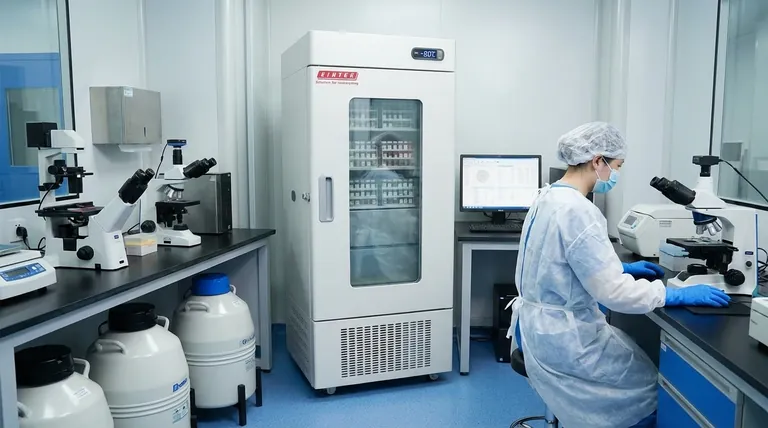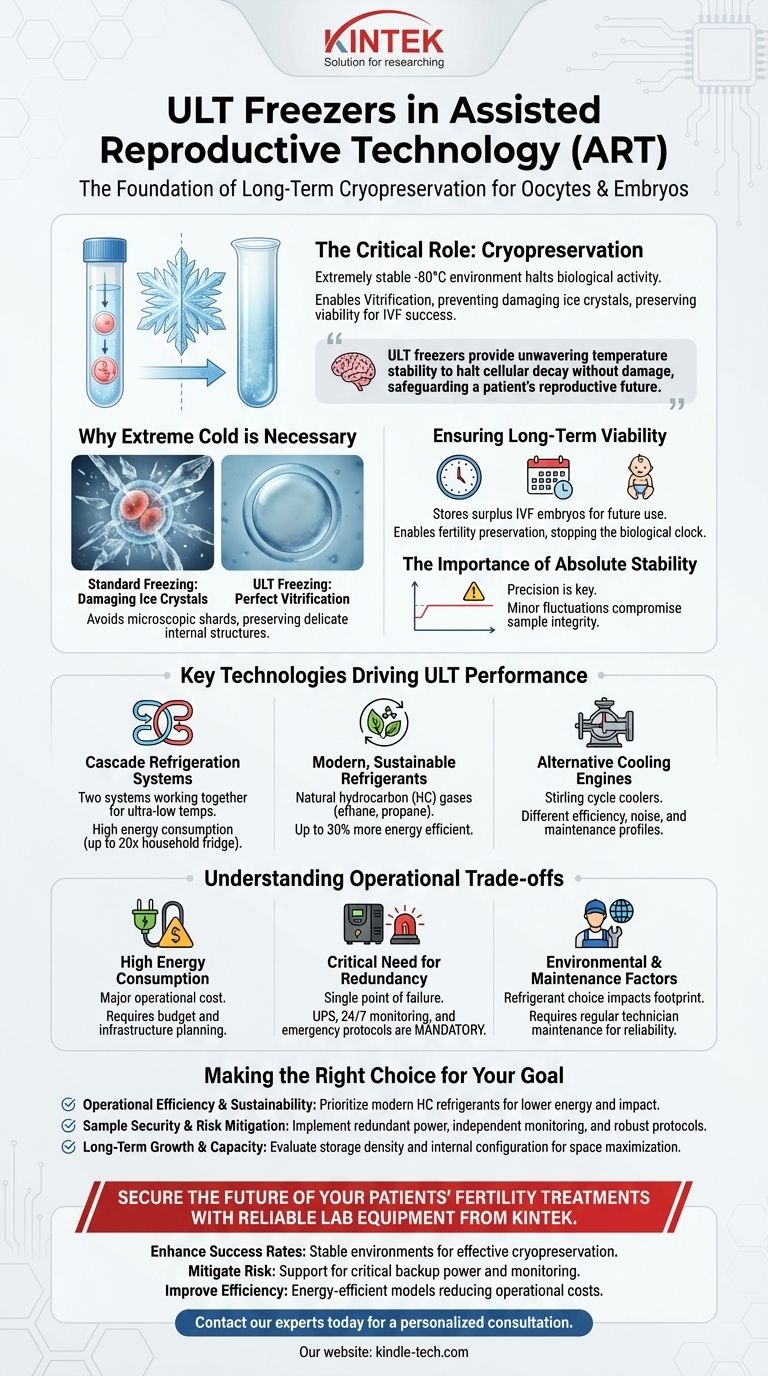In the world of Assisted Reproductive Technology (ART), Ultra-Low Temperature (ULT) freezers serve one primary, critical function: the long-term cryopreservation of human oocytes (eggs) and embryos. These specialized freezers create an extremely stable, cold environment (typically -80°C) required to pause all biological activity. This process, known as vitrification or slow-freezing, preserves the viability of these delicate cells, directly enhancing the success rates of fertility treatments like In-Vitro Fertilisation (IVF).
The core challenge in ART is preserving the biological integrity of irreplaceable gametes and embryos over time. ULT freezers solve this not merely by being cold, but by providing the unwavering temperature stability necessary to halt cellular decay without causing damage, thereby safeguarding a patient's reproductive future.

The Critical Role of Cryopreservation in ART
The ability to successfully freeze and thaw reproductive material has revolutionized fertility treatment. ULT freezers are the cornerstone of this capability.
Why Extreme Cold is Necessary
Standard freezing creates ice crystals, which act like microscopic shards of glass that would shred the delicate internal structures of an oocyte or embryo. ULT freezers enable protocols that prevent this damage by maintaining temperatures so low that cells enter a glass-like, vitrified state, preserving them perfectly until they are needed.
Ensuring Long-Term Viability
The stable environment of a ULT freezer allows clinics to store surplus embryos from a successful IVF cycle for future attempts. It also enables fertility preservation for patients facing medical treatments or for those who wish to delay childbearing, effectively stopping the biological clock for their stored cells.
The Importance of Absolute Stability
Even minor temperature fluctuations can compromise the integrity of cryopreserved samples. The primary design goal of a ULT freezer is to maintain its target temperature with extreme precision, providing a secure and stable environment that is essential for the long-term success of stored biological materials.
Key Technologies Driving ULT Performance
Modern ULT freezers are sophisticated instruments. Understanding the technology inside them helps clarify their role and operational considerations.
Cascade Refrigeration Systems
Many ULT freezers use a cascade refrigeration system, which is essentially two cooling systems working together to achieve ultra-low temperatures. While effective, these systems are known for their high energy consumption, often using up to 20 times the energy of a standard household refrigerator.
Modern, Sustainable Refrigerants
To improve efficiency and reduce environmental impact, newer ULT freezers have moved away from older greenhouse gas fluids. They now use natural hydrocarbon (HC) gas mixtures, such as ethane and propane, which can improve energy efficiency by up to 30% over older systems.
Alternative Cooling Engines
Some advanced ULT freezers utilize Stirling cycle coolers. This alternative refrigeration technology can offer different benefits in terms of efficiency, noise, and maintenance profiles compared to traditional cascade systems.
Understanding the Operational Trade-offs
While essential, implementing ULT freezers in a clinical setting requires careful consideration of their operational demands and potential pitfalls.
High Energy Consumption
The significant energy draw of ULT freezers is a major operational cost for any ART lab. This expense must be factored into the clinic's budget and infrastructure planning.
The Critical Need for Redundancy
A ULT freezer represents a single point of failure for what is arguably the most valuable material in the entire clinic. Comprehensive backup plans, including uninterruptible power supplies (UPS), 24/7 temperature monitoring alarms, and clear emergency protocols, are not optional—they are mandatory.
Environmental and Maintenance Factors
The choice of refrigerant impacts not only energy bills but also a clinic's environmental footprint. Furthermore, these are complex machines that require regular maintenance by trained technicians to ensure their reliability and protect the priceless samples stored within.
Making the Right Choice for Your Goal
Selecting and managing a ULT freezer strategy is a critical decision for any ART program.
- If your primary focus is operational efficiency and sustainability: Prioritize ULT freezers that use modern hydrocarbon (HC) refrigerants to lower energy consumption and minimize environmental impact.
- If your primary focus is sample security and risk mitigation: Your top priority must be implementing a system of redundant power, independent temperature monitoring, and robust emergency protocols.
- If your primary focus is long-term growth and capacity: Evaluate freezer models based on their storage density and internal configuration to ensure you are maximizing the use of valuable laboratory space.
Ultimately, the right ULT freezer is a foundational investment in the security, viability, and success of your assisted reproduction program.
Summary Table:
| Key Aspect | Role in ART |
|---|---|
| Primary Function | Long-term cryopreservation of oocytes and embryos. |
| Critical Feature | Unwavering temperature stability to prevent cellular damage. |
| Key Benefit | Enables fertility preservation and storage of surplus IVF embryos. |
| Operational Focus | Requires redundancy plans (UPS, alarms) and energy-efficient models. |
Secure the future of your patients' fertility treatments with reliable lab equipment from KINTEK.
As a specialist in laboratory equipment and consumables, KINTEK understands that the integrity of cryopreserved eggs and embryos is paramount to your ART program's success. We provide the robust, high-performance ULT freezers and supporting infrastructure you need to ensure sample viability and operational reliability.
We help you:
- Enhance Success Rates: With equipment that guarantees the stable environments required for effective cryopreservation.
- Mitigate Risk: Through solutions that support critical backup power and monitoring systems.
- Improve Efficiency: By offering energy-efficient models that reduce operational costs.
Let's discuss how our lab solutions can support your specific needs. Contact our experts today for a personalized consultation.
Visual Guide

Related Products
- 508L Advanced Vertical Ultra Low Temperature Freezer for Critical Laboratory Storage
- 408L Advanced Vertical Laboratory Ultra Low Temperature Freezer for Critical Research Material Preservation
- 608L Essential Laboratory Ultra Low Temperature Freezer For Critical Sample Preservation
- 708L Ultra Low Temperature Freezer High Performance Laboratory Freezer
- 28L Compact Upright Ultra Low Temperature Freezer for Laboratory
People Also Ask
- What advantages do ultra-low temperature freezers offer? Ensure Long-Term Sample Integrity and Reliability
- What makes Ultra-Low Temperature freezers energy efficient? Key Design & Operational Strategies
- How do Ultra-Low Temperature freezers ensure the integrity of microbiological samples? Maintain Stability for Critical Research
- What factors should be considered when selecting an ultra-low temperature freezer? Ensure Sample Integrity and Long-Term Value
- What temperature range do Ultra-Low Temperature freezers maintain? The -80°C Standard for Sample Integrity



















